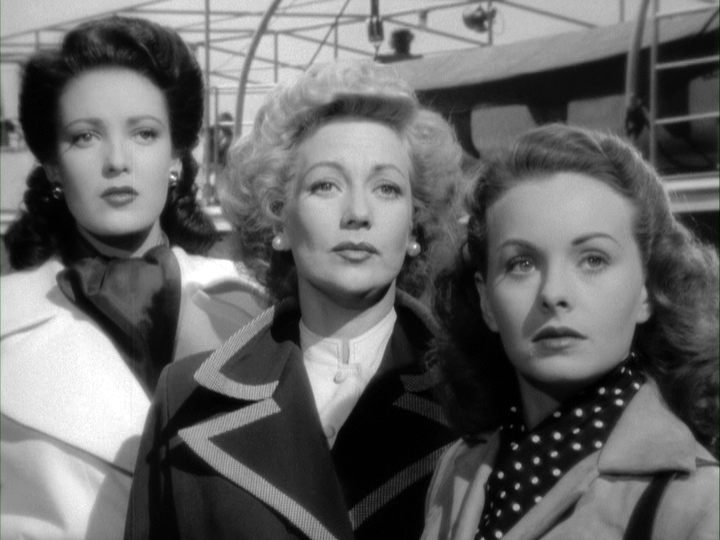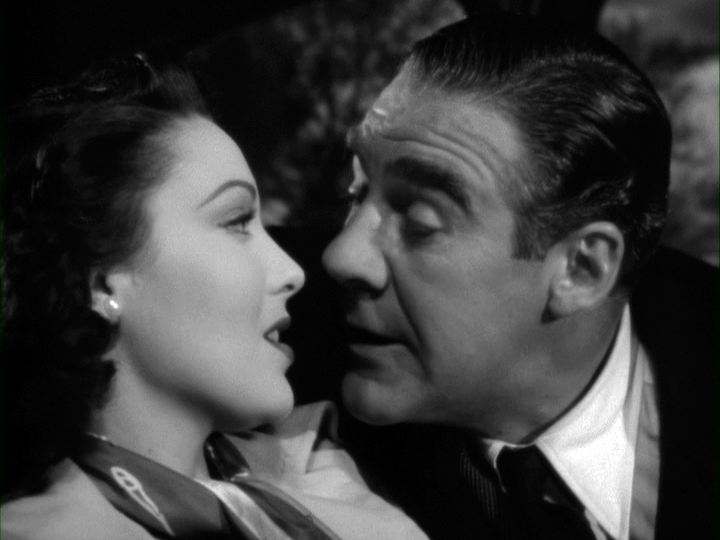A Letter to Three Wives, 1949, Twentieth Century Fox Films. Starring Ann Sothern, Linda Darnell, Jeanne Crain. Directed by Joseph Mankiewicz. B&W, 103 minutes.
Addie Ross, leading town socialite, has never failed to make men happy and women miserable. Now, however, it seems she’s left town for good. But before allowing the women to be satisfied with that, she’s done one last terrible thing: run off with another woman’s husband.
She left a letter for three of her top nemeses and had it delivered just as they are about to debark on a day-long boating trip for charity—and she’s about to leave with the man in question. There’s no doubt this man belongs to one of them, or did, but there’s no clue beyond that as to who he might be. The women are left to agonize, each in their own way, over the cracks in their marriages.

Linda Darnell, Ann Sothern, Jeanne Crain
Rita Phipps (Ann Sothern) and her husband George (Kirk Douglas) live an upscale life, largely due to her job as a writer of radio soap operas. He’s a schoolteacher, and happy for it, but there’s a challenge in having a wife whose salary essentially supports their lifestyle.
Deborah Bishop (Jeanne Crain) is adored by her husband Brad (Jeffrey Lynn), yet she’s always certain she’s coming up short in comparison to his country club friends. He’s growing weary of her insecurities, and when she last saw him, they’d argued over Addie.
Everyone, including the besotted Porter Hollingsway (Paul Douglas), is certain his wife Lora Mae (Linda Darnell) only married him for his money. With her dirt-poor background and unrefined behavior, her hold on him ultimately is perhaps tenuous.

Linda Darnell, Paul Douglas
The movie takes you through the lives and hearts of three very different women and their marriages, with no clear indication who the cheating husband might be until the last minutes. The ending appears obvious, but there’s a bit of a twist, and declarations between one couple change the story in more ways than one.
A Letter to Three Wives won the Academy Award for Best Director and Best Writing-Screenplay, and was nominated for Best Picture. Joseph Mankiewicz was both the director and screenwriter, and he would go on to win the same two awards for All About Eve the following year.
You never see Addie, by the way, although she narrates a great deal of the film. The uncredited role went to Celeste Holm, and audiences were left guessing who the actress might be. The studio didn’t miss a beat in capitalizing on this curiosity, holding “Who’s Addie?” contests across the country.
Another uncredited role was played by Thelma Ritter, the phenomenal character actress, as Rita’s maid—and Lora Mae’s friend.
The film was based on the novel A Letter to Five Wives, and original plans were to keep the same number of questioning wives. After some time it was pared down to four, and eventually all involved realized three was the most appropriate number for the film version.

Jeanne Crain, Ann Sothern, Kirk Douglas
The three women portray their vastly different characters with skill and depth, particularly Linda Darnell in the edgiest of the women’s roles, and the men in their lives are adeptly played as well, with special notice going to Paul Douglas in his screen debut. Douglas had been a long-time stage actor.
At the time of production, Darnell and Mankiewicz were involved romantically, although he was still married. She later left her husband, something that may have happened regardless of any outside influence, but her strong feelings for Mankiewicz were never matched.
A Letter to Three Wives is a story as real today as it was when it first was released; every town has its Addie Ross, and every married woman has her insecurities born of fragile moments in her marriage.

I have never seen this one, Belinda but, from your review, I wish I had! Good actors in it.
LikeLiked by 1 person
I’m not going to lie — it’s not as good as “All About Eve,” even though it was the same writer/director, but it is worth the watch.
LikeLike
This film is one of my favorites and each time I see it I’m confused and annoyed that Thelma Ritter is uncredited. She’s one of the essential characters. I understand Celeste Holm being uncredited because of the publicity opportunities. But Ritter appears often. Anybody know the answer to this?
LikeLiked by 1 person
I’ve asked the same question and would love to know the answer!
LikeLike